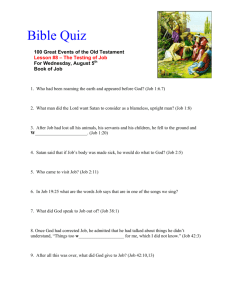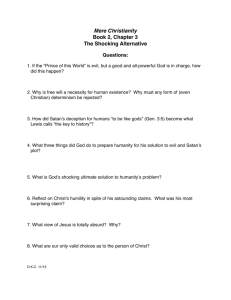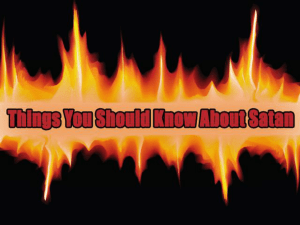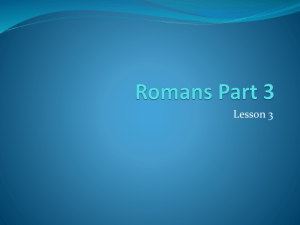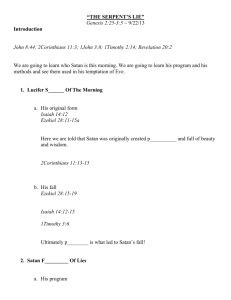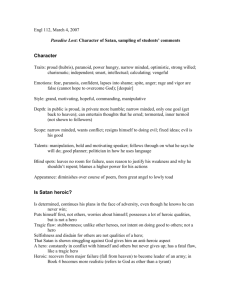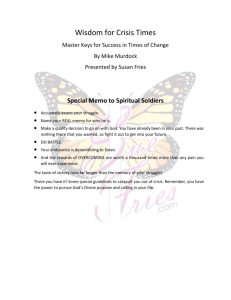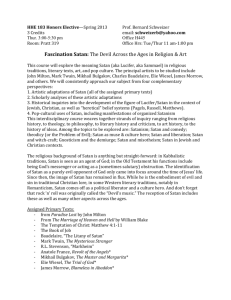The Game of Life
advertisement
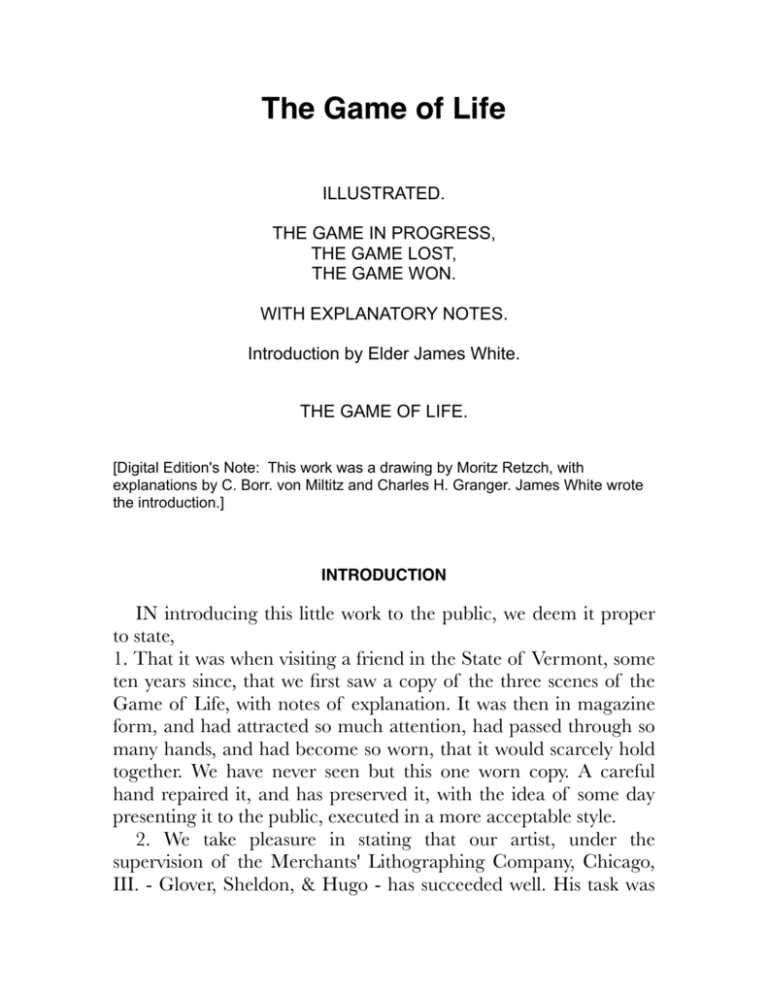
The Game of Life ILLUSTRATED. THE GAME IN PROGRESS, THE GAME LOST, THE GAME WON. WITH EXPLANATORY NOTES. Introduction by Elder James White. THE GAME OF LIFE. [Digital Edition's Note: This work was a drawing by Moritz Retzch, with explanations by C. Borr. von Miltitz and Charles H. Granger. James White wrote the introduction.] INTRODUCTION IN introducing this little work to the public, we deem it proper to state, 1. That it was when visiting a friend in the State of Vermont, some ten years since, that we first saw a copy of the three scenes of the Game of Life, with notes of explanation. It was then in magazine form, and had attracted so much attention, had passed through so many hands, and had become so worn, that it would scarcely hold together. We have never seen but this one worn copy. A careful hand repaired it, and has preserved it, with the idea of some day presenting it to the public, executed in a more acceptable style. 2. We take pleasure in stating that our artist, under the supervision of the Merchants' Lithographing Company, Chicago, III. - Glover, Sheldon, & Hugo - has succeeded well. His task was the more difficult on account of the worn and imperfect condition of the design, and his effort to change it in some objectionable features of the original idea. 3. This work is not denominational. It will be accepted by thoughtful Christians of all evangelical denominations, as a most impressive illustration of the great practical truths of the word of God. 4 4. The influence of this work must be good, and only good, upon all minds, in all stages of Christian experience. The mature Christian may, in these illustrations, view with the greatest satisfaction the dangers he has passed, and the victories he has gained; while those just entering upon the Christian life, may here learn lessons of great profit in coping with our common foe. J.W. August, 1870. THE GAME OF LIFE A DRAWING BY MORITZ RETZSCH, EXPLAINED BY C. BORR. VON MILTITZ THE name of our gifted artist, distinguished alike with the graver and the pencil, has been for so many years honored both at home and abroad, as that of an effective and picturesque poet; it has so often brought before us whatever is gentlest and loveliest, as well as whatever is terrible and awful, that we have become accustomed, at last, to associate it in our minds with all that is beautiful and sublime. Thus far, indeed, his marvelous talent has been chiefly lent to illustrate the works of poets, not only compatriots with himself, but foreigners. But here he has descended into the rich mines of his own genius, and, from their mysterious depths, has called up forms which must fill our hearts with terror and delight, with thoughtfulness, and with grief. For there are yet spirits - and, Heaven be thanked, their number is not small - who hold it to be the noblest exertion of Art, when it thus strives to address our human affections in the language of religious, pious, solemn contemplation. And Art knows how to strike those notes which vibrate with such power and depth, and echo so sweetly and so long; for devotion and love are in unison with the inspirations of Art, and if the first two choose the cathedral's lofty and silent arches for their secret and confiding outpourings, so, the Arts appear 5 with the attributes of their highest power and their gentlest consolations only on holy ground. Thus much as an introduction to a design by RETZSCH, which should be hung up above the table of every artist, in the oratory of woman's prayers, over the cradle of sleeping innocence and childhood. It is SATAN, the Spirit of Darkness, PLAYING WITH MAN FOR HIS SOUL. The scene is chosen with a sort of mysterious reference to the whole idea that is to be expressed. The very architecture intimates the presence of that dark being to whose sphere belongs all that is horrible, confounding, and seductive. It is a wide vault, whose arch is formed by two lizard-shaped monsters, whose heads, half bird, half locust, as well as their short, misshapen claws, adhere closely to the two pillars, down which they seem to creep. The upper surface of a sarcophagus is transformed into a chess-board; and MAN, as a fair youth, sits at the table, his head, covered with the curls of early manhood, resting on his hands, and his countenance full of careful thoughts. Opposite to him, on the spectator's left hand, is SATAN, the Prince of Darkness, seated in a large chair, one of whose arms shows an open-mouthed lion, "seeking whom he may devour," while, lower down, the claw of a lion grasping a human skull, intimates his death-bringing power. A broad cloak, from which only his bony, clawlike hands appear, is thrown around him, and his hair and his beard bristle wildly about. In his cap is the long, crooked, cock's feather, which ancient tradition has uniformly regarded as suspicious. The features of his countenance are noble, for he is still a fallen angel; but their expression, as becomes his fallen state, is devilish and hateful. He who was a liar from the beginning; he who plays falsely; he who breaks with all confederates, is undeniably before us, with all the coldness of a tiger, and with all the cruelty of a hyena. Contumely, scorn, hatred, malice, rejoicing in mischief, may find here their appropriate features; and the hand on the chin may either conceal a demoniacal smile at the prize it is about to seize, or repress a horrid imprecation, before which the gates of hell would tremble, that deliverance may still be possible. 6 Between the two players, somewhat in the back-ground, stands a gentle, lovely angel-form, with white and out-spread wings, - a son of the MORNING, the PROTECTING spirit of this human being, but not seen by him. To thrust him away is beyond Satan's power; the human being alone can renounce or reject him. But, on the other hand, the Genius himself, like conscience, can only gently warn, not directly counsel nor absolutely control conduct. He looks down in sorrow upon the critical state of the game; and is already partly turned away from the trust committed to his charge. But now let us look again at the game itself. The form of the KING on Satan's side, represents himself, muffled indeed in his cloak, but still to be recognized at the first glance. His forces are pressing eagerly forward. His QUEEN, a voluptuous female figure, with an unveiled bosom, is PLEASURE, whose right hand draws her robe tightly around her alluring charms, while her left offers the cup of intoxication. The officers are six VICES: 1. INDOLENCE sitting on an unhewn block of wood, a heavy, full form, with the head of a swine, hanging, misshapen arms, and clumsy legs. 2. ANGER, rash and headlong, like the turkey-cock, that flies into a rage with every object it meets, wears the head of this bird, and, fluttering his wings, bristles sharp quills upon his neck and back. 3. PRIDE, grave, moving stiffly forward, wearing on his head, which is tossed backward, a feather crown, one arm insolently thrust into his side; but forgetful, while he displays his splendid peacock's tail, how much of what disgraces him he leaves naked behind. One hand holds a full purse; the other is stretched out as if giving command. 4. FALSEHOOD, a form spotted like a tiger's, with the head of a cat, and the ears laid fawningly back. One hand is laid, as if to assure good faith, upon her breast, while the other hides a dagger behind her back. 5. AVARICE and ENVY in one person, a bent, lean figure, gnawing its own hand, and pressing a casket closely under its arm. 6. UNBELIEF, an impudent, horned figure, both 7 hands thrust into its sides, and overthrowing a cross with its foot. The eight PAWNS are DOUBTS; small, harpy-shaped creatures, with wings like bats, and sharp teeth. On the side of the human being, his own soul is represented as the KING, with a broad robe, firmly and anxiously drawn about him, and the wings of a butterfly on his shoulders. The QUEEN of RELIGION, the most powerful of all defenses; a lofty, majestic figure with ample pinions, stretching out one hand as giving protection, and holding in the other the sign of expiation. The officers are, 1. HOPE, with her anchor. 2. TRUTH, with a lighted torch and a reflecting shield, stands with Hope as a castle on her side. 3. PEACE, with the palm. 4. HUMILITY, her head bent in prayer, and her person sparingly clad. 5. INNOCENCY, a naked child, stretching forth its arms confidingly to all. 6. LOVE, two children embracing each other, cheek pressed against cheek. The pawns are here represented as angels' heads, winged and worshiping. They signify PRAYER; for as an officer, who has been lost, may be recovered, in chess, by a pawn, so may a spiritual loss often be recovered by prayer. The game stands ill for the human being. His adversary has already weakened the power of prayer, by taking from him several angels' heads. LOVE and INNOCENCE are lost; HUMILITY gone; and PEACE, just seized, is still held in his claw-like fingers. PLEASURE, UNBELIEF, and evil DOUBTS, are pressing tumultuously forward against RELIGION, who stands there tranquil and sublime, protecting MAN, who is thus attacked in so many ways, but who, so long as he does not give up RELIGION, may yet hope for escape. Unhappy MAN himself has only vanquished ANGER, and overcome a single DOUBT. Whether, therefore, we regard the originality of the invention, or the perfect keeping of the allegory, this design will remain one of the happiest creations of genius and art. The mind that willingly turns its thoughts upon what is most serious 8 in life, cannot easily remain unmoved by the deep meaning of the idea here represented; while many a presumptuous spirit beholding PEACE already in Satan's hands, INNOCENCE gone, DOUBTS urgent, and the assured prospect that the bold game itself must be lost if RELIGION be sacrificed, may yet cast a searching look upon what is passing within himself. THE GAME LOST AND THE GAME WON - BY CHARLES H. GRANGER. In offering these designs to the public, the publisher deems it proper to make but few remarks. The "GAME OF LIFE," by Moritz Retzsch, has gained a well deserved celebrity, as being a beautiful and highly poetical allegory; and there can be no doubt that all discerning and thoughtful persons, with the aid of the accompanying description, will appreciate its excellence without any additional comment. With regard to the GAME LOST, and the GAME WON, the designer will only say that he has endeavored to carry out the allegory, by showing the possible results of the game. In the GAME OF LIFE all is quiet, and there is an awful stillness of intense expectation. Satan has just taken away peace of mind from man, and is gazing upon him with a malignant expression of anticipated triumph; while man seems to be anxiously debating what shall be his next move; and the guardian angel looks on with an expression of pity and compassion. The very carved lion upon the chair of Satan, and the monsters upon the wall, are made to glare upon man, as if ready to spring upon him should he lose the game. The GAME LOST represents the triumph of Satan, the despair of man, and the mournful disappointment of the guardian angel. The cover of the sarcophagus being removed, Death rises mid smoke and flames, and strikes man with his dart. All is confusion and uproar. In the GAME WON, quiet is again restored. Man, in an attitude of religious devotion, turns toward the angel, who points upward with a look of encouragement and approval. The lion crouches asleep, and cherubs preparing wreaths occupy the places of the monsters upon the walls, while the cross, book, and roses, upon the sarcophagus, show that death and the grave are no longer subjects of fear. Satan has disappeared; and the robe and cap, with the broken plume, alone remain to show his discomfiture. PICTURE - THE GAME OF LIFE. PICTURE - THE GAME LOST. PICTURE - THE GAME WON.
